Arizona, a land of stunning arid and semiarid landscapes and breathtaking natural wonders, is home to some of the most remarkable state parks in the southwest United States. These diverse and expansive natural areas offer a glimpse into this state’s unique beauty and ecological richness. In this article, we delve into the largest state parks in Arizona, from the largest to the smallest. Regardless of size, each state park is a testament to the Arizona State Park’s commitment to preserving its natural and cultural heritage.
From the serene shores of Cattail Cove State Park to the rugged wilderness of Picacho Peak State Park, these protected areas encompass a wide range of ecosystems and recreational opportunities. Some were established as early as 1961, and as recently as 2001, these state parks have a rich history and ecological significance. Each park offers a distinctive experience. Some are rich with opportunities to experience water-based activities, hiking adventures, or a chance to observe native wildlife.
Let’s discover the vast landscapes, unique features, and opportunities for outdoor recreation that make these parks a source of pride for the state and a haven for those seeking outdoor experiences.
San Rafael State Natural Area
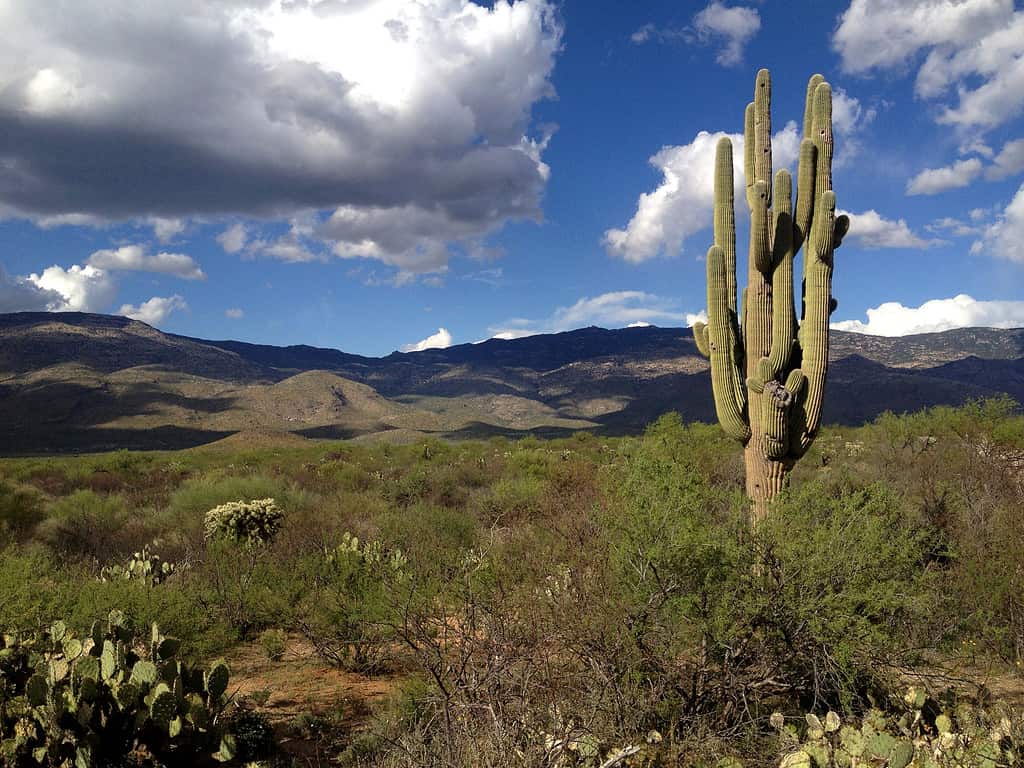
Residing in southern Arizona, San Rafael State Natural Area is the largest state park in the state with over 22,000 acres.
©Piotr Szafruga/iStock via Getty Images
San Rafael State Natural Area holds an impressive 22,000 acres. Moreover, it is a hidden gem in Arizona’s diverse landscape that was established in 1999. This natural area, managed by the state parks system of Arizona, serves as a refuge for native plant and animal species. It is a unique area with rolling hills and native grasses in southern Arizona.
About the State Park and Things To Do
It is home to incredible wildlife viewing and breathtaking scenery. Popular activities at the San Rafael State Natural include hiking along its trails, where the mesmerizing beauty of this unique area dazzles the eye. Moreover, the park’s diverse ecosystem supports a variety of wildlife, including bobcats, Mexican garter snakes, Huachuca tiger salamanders, Sprague’s pipit, Gila monsters, and many more, providing excellent opportunities for wildlife observation.
Furthermore, the San Rafael Ranch, a historic cattle ranch, is also located in the state park. Reading in the San Rafael Valley, the purpose of the San Rafael State Natural Area is a commitment to preserving the pristine habitat. This dedication ensures that visitors can experience the natural world as it has existed for centuries, unspoiled by development and protected for years to come.
One of the closest towns to the San Rafael State Natural is Patagonia. The town is located roughly 20 miles northwest of the state park. Additionally, the San Rafael State Natural is within reasonable driving distance of Tucson, making it an accessible destination for those seeking its charming beauty.
Sonoita Creek State Natural Area
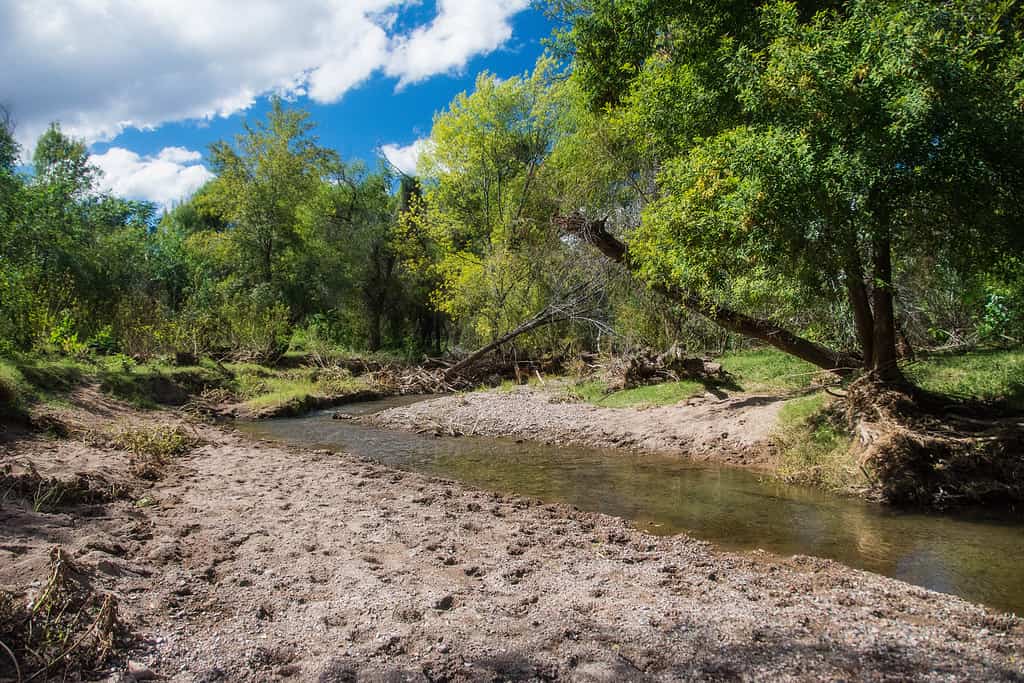
Sonoita Creek State Natural Area contains over 9,580 acres of land and is adjacent to Patagonia Lake State Park.
©MarciParavia/iStock via Getty Images
In southern Arizona, the Sonoita Creek State Natural Area encompasses a vast expanse of over 9,580 acres. This state natural area, categorized as a state park, was initially established in 1994. Here, visitors are welcomed into a world of striking diversity, where the arid desert landscape meets the vibrant riparian habitat along Sonoita Creek, adjacent to Patagonia Lake State Park.
About the State Park and Things To Do
This unique sanctuary offers a plethora of activities that cater to both seasoned naturalists and casual explorers. Bird watchers flock here to catch a glimpse of over 300 species of birds. A few species include the magnificent vermilion flycatcher, the elusive yellow-billed cuckoo, and the vivid trogon. There are about 20 miles of hiking trails wind through the landscape, eight of which are shared with equestrians. In addition, these trails provide opportunities to encounter the unique flora and fauna that thrive in the fragile ecosystem this state park protects.
Moreover, what truly sets Sonoita Creek apart is its extraordinary riparian and upland area. It is an oasis of life amid the arid surroundings. Here, towering cottonwood, ash, mesquite, and willow trees provide shade and diversity, starkly contrasting the sun-scorched desert. The area is also home to the threatened Gila topminnow, a species of fish that is a part of the Poeciliidae family.
Sonoita Creek State Natural Area is conveniently located near the charming town of Patagonia, which is accessible less than 11 miles by car. It is also within easy reach of Tucson, one of Arizona’s major cities, sitting roughly 75 miles south of the city. Furthermore, this state park is ideal for those who consider themselves avid birders, nature enthusiasts, hikers, or simply someone seeking a serene escape into the natural world.
Catalina State Park
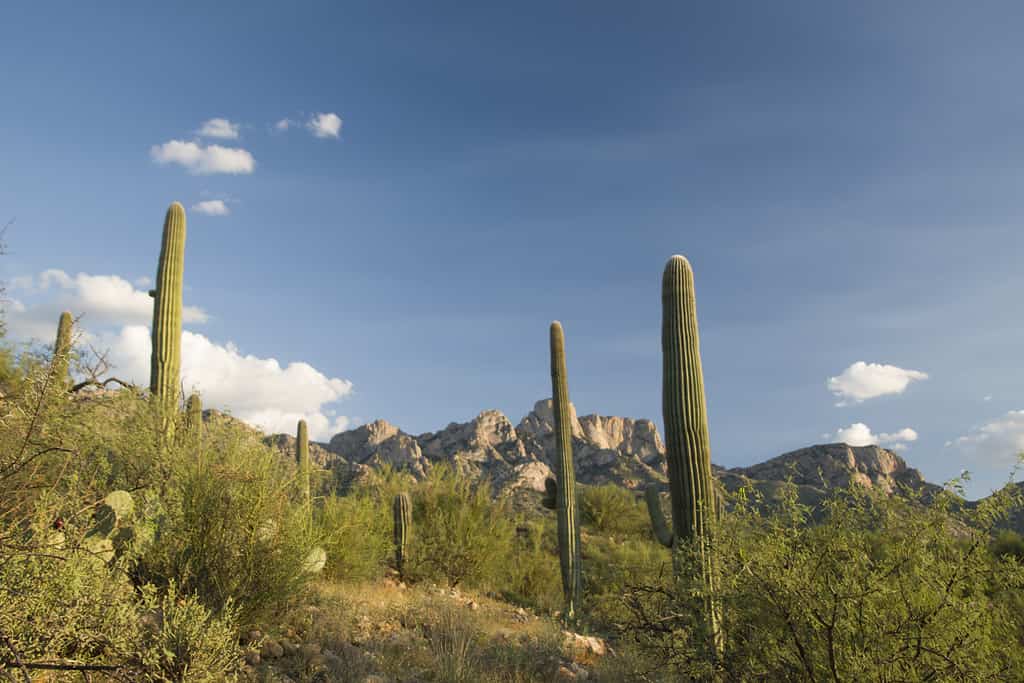
Catalina State Park resides along the foothills of the western Santa Catalina Mountains and contains approximately 5,490 acres of land.
©Jesseofthedesert/iStock via Getty Images
Amidst the majestic Santa Catalina Mountains, specifically along the western side, Catalina State Park spans approximately 5,490 acres of rugged terrain and breathtaking vistas. Its borders consist of foothills, canyons, and streams. Moreover, this state park was established in 1983 and resides only 12 miles north of the city of Tucson. Not only is this park a testament to Arizona’s commitment to preserving its natural beauty, but it is also a unique location that provides convenient outdoor recreation opportunities and is a playground for exploration.
About the State Park and Things To Do
Catalina State Park is a great state park for hikers, with a network of eight trails that wind through the picturesque desert landscape, offering varying levels of challenge and reward. Moreover, the shortest trail at 0.75 miles, the Romero Ruins Interpretive Trail, takes visitors on a journey through the remnants of an ancient Hohokam village. This trail provides a glimpse into the area’s rich history that dates back approximately 1,500 years. Furthermore, the longest trail at 9.1 miles, the Sutherland Trail, winds through the Cargodera Canyon and has a total elevation gain of 5,900 feet. Aside from hiking, seven of the eight trails allow biking and horseback riding.
One of the park’s most popular activities is bird-watching. Furthermore, Catalina State Park is recognized by the Audubon Society as an Important Birding Area (IBA). There are over 190 species of birds calling this area home. Hawks, owls, wading birds, and colorful songbirds are frequent sights, making it a prime destination for ornithologists and casual bird enthusiasts alike. Picnicking, camping, and wildlife observation are also popular activities here, with opportunities to spot desert creatures like javelinas, coyotes, coatis, and rattlesnakes.
Moreover, what truly distinguishes Catalina State Park is its rich historical and ecological significance. The ancient Hohokam ruins scattered throughout areas of the park offer a tangible connection to Arizona’s indigenous history. Additionally, the park showcases a diverse range of desert flora and fauna, from iconic saguaro cacti to rare bobcats.
Alamo Lake State Park

Alamo Lake State Park is situated on Alamo Lake in western Arizona. It contains around 4,900 acres.
©Julia Nelson/iStock via Getty Images
Spanning an impressive 4,900 acres, Alamo Lake State Park is another sprawling oasis in the western Arizona landscape. This park was established in 1969.
About the State Park and Things To Do
The centerpiece of Alamo Lake State Park is undoubtedly Alamo Lake itself. This artificial reservoir plays a vital role in flood control and provides water-based recreation in this arid region. At around 48 square miles, the lake is a destination for anglers, offering excellent fishing opportunities for bass, catfish, tilapia, sunfish, and crappie. Boating, swimming, and camping are also popular activities, with campgrounds providing stunning views of the lake and the surrounding desert.
Moreover, beyond the aquatic attractions, the park offers ample opportunities for wildlife viewing. Desert bighorn sheep, wild burros, mule deer, and a variety of bird species, including the iconic bald eagle, can be spotted in this diverse ecosystem.
What makes Alamo Lake State Park unique is its role as flood control for the surrounding landscape. Furthermore, the park resides 34 miles north of the community of Wenden, which provides a gateway to this natural oasis. Phoenix, a major city in Arizona, is farther away, situated roughly 133 miles southeast of the state park.
Homolovi State Park

Homolovi State Park resides in northeastern Arizona and holds about 4,000 acres of land.
©Cavan Images/iStock via Getty Images
According to Arizona State Parks, Homolovi State Park encompasses an area of roughly 4,000 acres. It is a cultural and archaeological treasure and was established in 1986. Located in northeastern Arizona, this park offers a unique blend of history, archaeology, and natural beauty that appeals to both history enthusiasts and outdoor adventurers. Moreover, it is roughly 58 miles west of the Petrified Forest National Park.
About the State Park and Things To Do
The park is deeply rooted in Native American history, with ancient pueblos and petroglyphs that provide a captivating glimpse into the past amongst over 300 archaeological sites. Visitors can respectfully explore these archaeological sites, gaining insight into the lives of the indigenous people who inhabited this region centuries ago. The petroglyphs, in particular, offer a window into the expressions of the Hopi.
Hiking is another activity in Homolovi State Park, with a handful of easy trails leading through the starkly beautiful desert landscape. These trails offer not only opportunities for physical activity but also moments of solitude and reflection amid the Arizona landscape of this region.
Furthermore, what makes Homolovi significant is its role in preserving Hopi cultural heritage and its status as a place of reverence for the Hopi people. The park provides a unique opportunity to learn about the rich culture and history of this indigenous community.
Homolovi State Park is closest to the town of Winslow, less than 7 miles away by car. This town is known for its iconic Standin’ on the Corner Park, commemorating the Eagles’ song “Take It Easy.” Additionally, the state park is roughly 65 miles east of Flagstaff, a major city in the region. Moreover, it is a convenient stop for travelers interested in exploring the intersection of history, culture, and nature in Arizona.
Oracle State Park

Residing in Pinal County in southeastern Arizona, Oracle State Park encompasses around 4,000 acres.
©Jonathan Ross/iStock via Getty Images
Oracle State Park, containing over 4,000 acres, stands as a serene sanctuary in Pinal County in southeastern Arizona. With its opening in 2001, this park has a multifaceted appeal that draws nature enthusiasts, history buffs, and those seeking tranquility in the desert.
About the State Park and Things To Do
One of the park’s prominent features is its extensive trail system with over 24 miles of trails, which offers visitors of all experience levels the chance to explore the diverse desert flora and fauna by foot, bike, or horse. Hikers can choose from a variety of trails, each offering unique vistas and experiences. The iconic Kannally Ranch House punctuates the park’s rugged terrain. Moreover, this historic Revival Style villa has Moorish influences and serves as a window into the past.
Oracle State Park also resides in the northern foothills of the Santa Catalina Mountains. Many species call these lands home, including the coyote, Coues deer, white-tailed deer, bobcat, gray fox, javelina, cottontail rabbits, skunks, and many more. Bird-watching is also a popular activity here, with over 150 species of birds recorded, making it a paradise for ornithologists. Lastly, Oracle State Park is an International Dark Sky site, making it a popular destination for stargazing.
The park is about 2 miles east of the town of Oracle and roughly 35 miles northeast of Tucson. It is easily accessible for those seeking a serene escape into nature. Furthermore, Arizona State Park’s commitment to conservation underscores the organization’s dedication to maintaining the conservation of the environment, its animals, and the delicate balance of the ecosystem.
Picacho Peak State Park
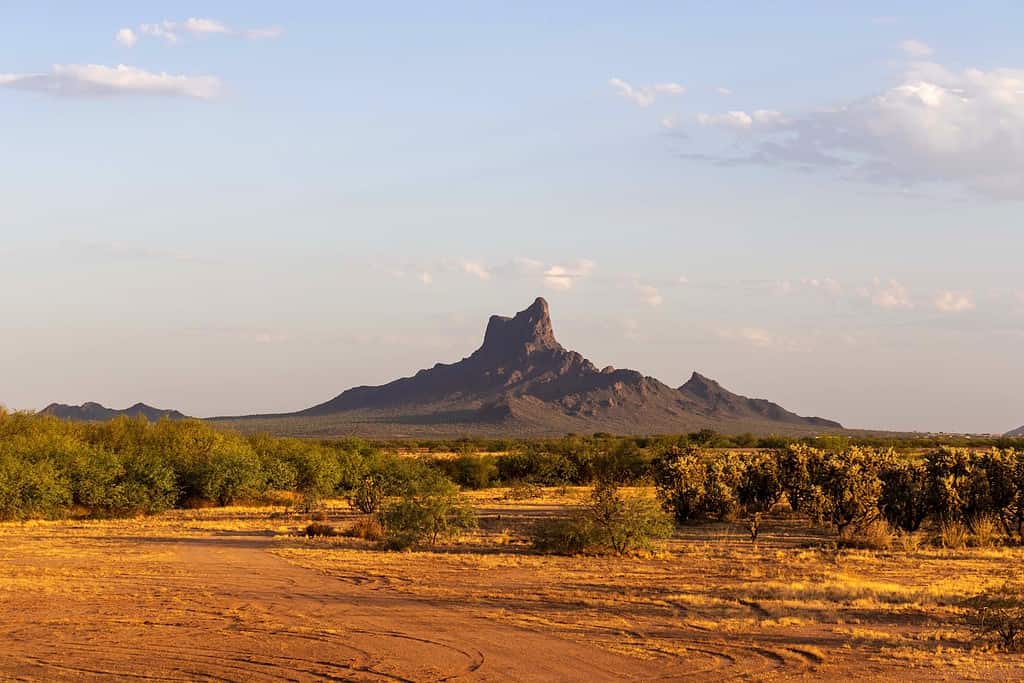
Home to the incredible Picacho Peak, which is a 1,500-foot peak that is popular amongst climbers, Picacho Peak State Park contains over 3,740 acres.
©Christopher Harris/iStock via Getty Images
Picacho Peak State Park spans over 3,740 acres. It boasts a landscape dominated by the iconic Picacho Peak, a 1,500-foot peak rising dramatically from the desert floor. Furthermore, the park was established in 1968 and offers a unique blend of natural beauty and recreational opportunities.
About the State Park and Things To Do
There is ample camping in the state park. Moreover, hikers and climbers flock to Picacho Peak for the challenge and reward it presents. The Hunter Trail, one of five trails in this state park, is demanding but provides stunning panoramic views. Moreover, it is a challenging route that is not for the faint of heart. The park’s rugged terrain also makes it a popular destination for climbing enthusiasts who navigate the difficult terrain.
What makes Picacho Peak significant is its geological uniqueness. The peak itself is the remnant of an ancient volcanic lava flow, a testament to Arizona’s dynamic geological history. Its prominence also made it a strategic point during the Civil War. The Battle of Picacho Pass took place on April 15, 1962, which adds another layer of historical significance.
The closest town to Picacho Peak State Park is the small community of Picacho. The town resides 7 miles northwest of the state park. Furthermore, Picacho Peak State Park is conveniently situated between Tucson and Phoenix along Highway 10. This makes it a common stop for travelers exploring the state’s natural wonders.
Patagonia Lake State Park
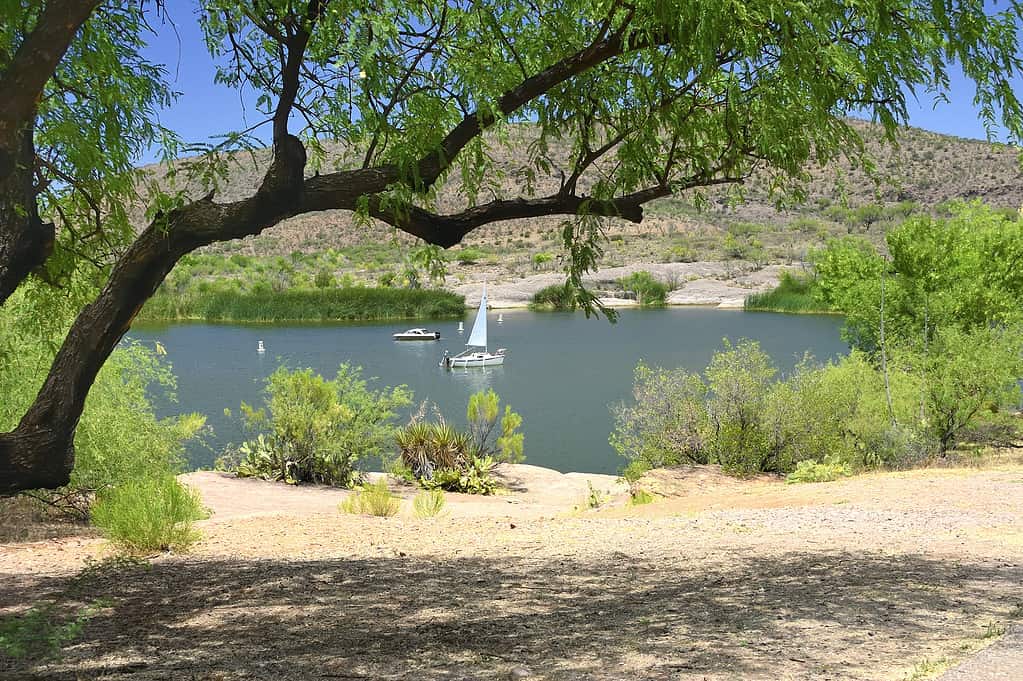
Patagonia Lake State Park is known for its water-based recreation and holds approximately 2,650 acres.
©Bob Balestri/iStock via Getty Images
Adjacent to Sonoita Creek State Natural Area, Patagonia Lake State Park has approximately 2,650 acres of serene beauty. Moreover, it was established in 1975. This park is a paradise for water-based recreation. It offers a range of aquatic activities, including motorized boating, kayaking, fishing, swimming, and more in the crystal-clear waters of Patagonia Lake. However, personal watercraft, water bikes, above-water exhaust boats, jet skis, and V-8 jet boats are prohibited from the lake. Moreover, the lake itself, a man-made reservoir, spans over 265 square acres.
About the State Park and Things To Do
One of the park’s significant features is its role as a vital stopover point for migratory birds. This makes it a prime destination for bird watchers. Over 300 bird species have been documented here, making it a birding hotspot. The lush riparian habitat along Sonoita Creek, which feeds into the lake, provides a haven for both resident and migratory birds. Furthermore, you can spot species such as tanagers, vermilion flycatchers, black vultures, hummingbirds, canyon towhee, Inca doves, and many more.
Moreover, beyond bird-watching, Patagonia Lake State Park offers opportunities for beach-side activities, picnicking, and camping. This state park allows visitors to immerse themselves in the beauty of the natural surroundings. This state park is not known for hiking. However, the nearby Sonoita Creek State Natural Area provides over 20 miles of extensive hiking trails.
Moreover, what sets this park apart is its unique blend of water-based recreation and abundant wildlife. It is a destination for swimming, fishing, and boating. There are multiple boat ramps and boat rentals available in the state park. Patagonia Lake is a prime location for anglers, with ample fishing opportunities from shore and by boat. Furthermore, popular fish species include trout, catfish, and largemouth bass.
The closest town to Patagonia Lake State Park is Patagonia, a charming community that shares its name with the park. The state park is roughly 78 miles south of Tucson. It offers a tranquil escape from the hustle and bustle of urban life. Furthermore, this makes it an ideal destination for those seeking relaxation by the water’s edge.
Cattail Cove State Park

Residing on the eastern shores of Lake Havasu, Cattail Cove State Park encompasses about 2,000 acres.
©Cheri Alguire/iStock via Getty Images
Cattail Cove State Park, encompassing approximately 2,000 acres, is a convenient gem along the shores of Lake Havasu in Arizona. This state park was established in 1970. Furthermore, it offers an easy-to-access escape into the beauty of Lake Havasu and the Colorado River and its surrounding desert landscape.
About the State Park and Things To Do
Popular activities at Cattail Cove State Park include boating, fishing, swimming, and camping. The park’s picturesque shoreline is perfect for launching boats of all kinds. In addition to exploring the lake’s many hidden coves or expansive blue waters. Anglers flock here for the chance to catch many different species in the clear waters of the lake. Some species include largemouth bass, catfish striped bass, channel catfish, flathead catfish, crappie, and bluegill.
Residing in western Arizona on the Arizona side along the California border, Cattail Cove State Park is surrounded by a desert landscape juxtaposed against the vibrant blue waters of the lake. It’s a haven for water-based recreation as well as bird-watching and wildlife viewing. There are plentiful opportunities to spot waterfowl, migratory birds, or the iconic desert bighorn sheep along the rugged hillsides.
The closest town to Cattail Cove State Park is Lake Havasu City. This city is a popular destination 15 miles northwest of the state park. It is known for the London Bridge and its recreational offerings. Additionally, it’s about 167 miles south of Las Vegas, NV.
List of the 9 Largest State Parks in Arizona
| Rank | Size | State Park |
|---|---|---|
| 1 | 22,000 acres | San Rafael State Natural Area |
| 2 | 9,580 acres | Sonoita Creek State Natural Area |
| 3 | 5,490 acres | Catalina State Park |
| 4 | 4,900 acres | Alamo Lake State Park |
| 5 | 4,000 acres | Homolovi State Park |
| 6 | 4,000 acres | Oracle State Park |
| 7 | 3,740 acres | Picacho Peak State Park |
| 8 | 2,650 acres | Patagonia Lake State Park |
| 9 | 2,000 acres | Cattail Cove State Park |
The photo featured at the top of this post is © Cheri Alguire/iStock via Getty Images
Thank you for reading! Have some feedback for us? Contact the AZ Animals editorial team.







